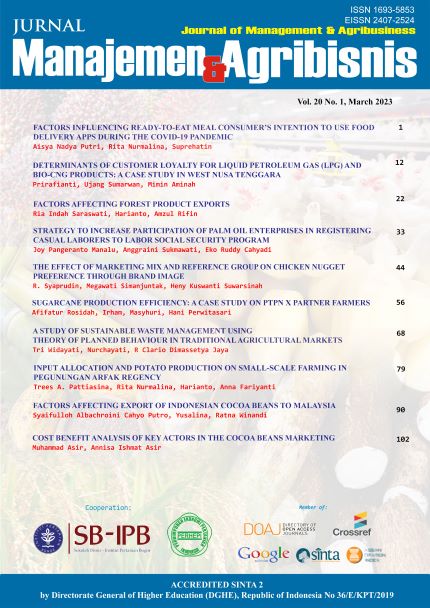The Effect of Goverment Policy and Market Failure on Divergence of Cassava Competitiveness in South Lampung
Abstract
Indonesia is one of the world's leading cassava producers, and Lampung Province is the main producer. Efforts to increase cassava production must be accompanied by good farming activities that link to a complete agribusiness system. This study aims to analyze the divergence effect of cassava competitiveness as an effect of government policies and market failure in South Lampung. This study was conducted using a survey method. The number of respondents was 64 cassava farmers, 8 cassava collectors, and 1 tapioca industry. Data collection was carried out in August-September 2022. This study uses PAM (Policy Analysis Matrix) to analyze the competitiveness and the divergence effect and market structure analysis to analyze the market failure. The result showed that there is a market failure of cassava because the market structure is not perfectly competitive (oligopsony). Therefore, the divergence effect of cassava did not reach the target because it caused the transfer of inputs prices from traders to farmers due to the fertilizer subsidy and the transfer of income from consumers to farmers due to the determination of cassava minimum price (Rp900/kg). However, cassava farming has a competitiveness with the value of comparative advantage (DRCR = 0.3091) which is smaller than the value of competitive advantage (PCR = 0.5865). The changes from comparative to competitive advantage require government policies to control market failure and to reduce the high transaction cost economy.
Keywords: divergence effect, market failure, cassava, oligopsony, agribusiness system
Authors
Authors who publish with this journal agree to the following terms:
- Authors retain copyright and grant the journal right of first publication with the work simultaneously licensed under a Creative Commons Attribution License that allows others to share the work with an acknowledgement of the work's authorship and initial publication in this journal.
- Authors are able to enter into separate, additional contractual arrangements for the non-exclusive distribution of the journal's published version of the work (e.g., post it to an institutional repository or publish it in a book), with an acknowledgement of its initial publication in this journal.
- Authors are permitted and encouraged to post their work online (e.g., in institutional repositories or on their website) prior to and during the submission process, as it can lead to productive exchanges, as well as earlier and greater citation of published work (See The Effect of Open Access).

